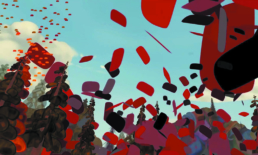May 7 – July 3, 2022
Land Back: Susan Blight, Quinn Hopkins, Devin Ronneberg & Kite, Casey Koyczan, Beric Manywounds, Michael Namingha, Lawrence Paul Yuxweluptun & Paisley Smith, Chandra Melting Tallow
Curator: Michael Patten
Contemporary Native Art Biennial (BACA) – 6th edition
Quai 5160 – Maison de la culture de Verdun
5160 Bd LaSalle, Verdun, QC H4H 1N8
Since time immemorial, Indigenous peoples have preserved biodiversity in the face of continued human population growth. Shortly after the time of first contact with Europeans, Indigenous communities were stripped of their ancestral lands; the Land Back movement aims to restore governance and stewardship of the territory for a sustainable future.
If Land Back is a call to action, a return of equity to a stolen territory, it also allows for some questioning. How can we best protect biodiversity, land and water? The first step would be to return the land to its traditional and legitimate protectors. The revalorization of Indigenous knowledge goes beyond symbolic gestures of recognition or inclusion; it aims to significantly change practices and structures.
In science fiction, as in the contemporary world, Indigenous communities are often excluded from the narrative. Usually associated with the past, Indigenous perspectives are rarely solicited in relation to the future world. Against this backdrop, many artists from the worlds of film, literature and visual arts have turned to Indigenous futurism: a concept theorized by Anishinabe professor Dr. Grace Dillon in her book Walking the Clouds: An Anthology of Indigenous Science Fiction (2003). Indigenous futurism is a multi-disciplinary artistic and cultural movement that aims to bring Indigenous insights to conversations about apocalypse, the supernatural, technology and more. As part of this movement, BACA wished to present a grouping of works and artists that address these themes through multiple mediums.
This exhibition, through a strong proposal of video works, brings together the works of artists Beric Manywounds, Casey Koyczan, Kite and Devin Ronneberg. A marked dialogue is established between Manywounds and Koyczan’s projections on the theme of spirituality in a mystical and marvelous aesthetic, while Kite and Ronneberg’s Fever Dream addresses the question of the supernatural in the Indigenous and non-Indigenous world allied to the fear of the end of the world.
These works are combined with virtual and augmented realities by the duo Lawrence Paul Yuxweluptun and Paisley Smith, and Quinn Hopkins; both pieces are deeply rooted in stories and creatures from Indigenous legends.
In a more material approach, Chandra Melting Tallow presents their installations Blood Count and IIKAAKIMAT in a discourse on the metaphysical and dream world. Susan Blight, also through the installation process, initiates a conversation about the silence of the general public and government authorities in the face of the crises facing Indigenous peoples. To do so, she uses a bearberry plant – a medicinal plant linked to Anishinaabe knowledge – as a vehicle. This echoes artist Michael Namingha’s Altered Landscape – abstract geometric and photographic compositions of aerial landscapes in the Four Corners region – which addresses the environmental impact of the oil industry.
We hope that this platform will further reflect on Indigenous perspectives in futuristic issues.
We would like to acknowledge that BACA is located on unceded Indigenous lands. The Kanien’kehá:ka Nation is recognized as the custodians of the lands and waters on which we gather today. Tiohtiá:ke commonly known as Montreal is historically known as a gathering place for many First Nations. Today, it is home to a diverse population of Indigenous and other peoples. We respect the continued connections with the past, present, and future in our ongoing relationships with Indigenous and other peoples within the Montreal community.
We recognize that BACA is taking place on unceded Indigenous lands, and that the Kanien’kehá:ka Nation is the caretaker of the lands and waters on which we gather today. Tiohtiá:ke (Montreal) is historically known as a gathering place for many First Nations. Today, it is home to a varied population of Indigenous and other peoples. BACA acknowledges the continued relations with the past, present, and future in their current relationships with Indigenous and other peoples within the Montreal community.
The Biennale d’art contemporain autochtone (BACA) thanks the Canada Council for the Arts, the Government of Québec (Conseil des arts et des lettres du Québec, Fonds d’investissement pour le rayonnement de la Métropole), Tourisme Montréal, the Conseil des arts de Montréal, Quai 5160 – Maison de la culture de Verdun and its other presenting partners.

